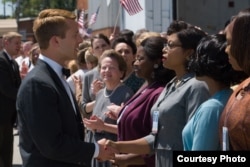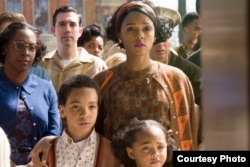Hidden Figures is the Hollywood version of the true story of three black women who in 1962 helped NASA launch pioneer astronaut John Glenn into orbit.
Katherine G. Johnson, Dorothy Vaughan and Mary Jackson broke the gender and race ceiling working as NASA mathematicians, computer experts and engineers during the Jim Crow era in the United States.
In the early 1960s, the space race between the US and the Soviet Union is in full force. Trailing the Soviets, NASA prepares for the first manned orbital mission. Hidden Figures looks at America's space program within the framework of American segregation.
Kevin Costner, who interprets Al Harrison, a composite of NASA managers, represents an equal opportunity boss, a scientist, whose only focus is getting a man into Earth orbit and beating the Russians to the moon. At a time when computers were only people with very high IQs and calculating skills, Harrison is looking for a mathematical genius within NASA to help his department compute the orbit trajectory for Glenn's flight.
The human computer scouting extends to the agency’s segregated West Area computing unit, where Dorothy Vaughn, the unit's acting manager, is trying in vain to convince her white supervisors to offer her the managerial position full time. She is also very aware of how skills and knowledge can make her and her unit of African American women indispensable to the agency.
Not only does Vaughn train herself and her team to learn the computer language of NASA's recently-installed IBM machines, she also recommends one of the women in her unit, mathematician Katherine Johnson, for the position of human computer Harrison is seeking.
Oscar winner Octavia Spencer interprets Dorothy Vaughn. During the film's premiere, at the National Museum of African American History and Culture in Washington, D.C., Spencer spoke to VOA about the significance of this untold story.
She said that the film "will hopefully compel us to continue to look for these diamonds and educate our children." Spencer, who has already garnered award nominations for her role, added“ there were ceilings broken at NASA but the fact that the world didn’t know who they are lets us know that we still have work yet to do.”
Taraji Henson interprets mathematician Katherine Johnson, the central figure in the story.
A mother of three and a modest genius, Johnson had one goal in mind: solve the problem. Her unfaltering computations keep John Glenn safe as he orbits the earth. But even as she computes high math she is experiencing racism and sexism at the office. Her white male counterparts mistake her for the cleaning lady.
When they reluctantly have to agree that she will be working among them, they install a small coffee pot with a label "colored" for her to use. And when she needs to go to the restroom, she has to walk across the entire NASA campus to the agency's segregated West Area computing unit. That changes when Harrison discovers the reason for her long absences, and furiously storms to the segregated western unit with a hammer, and tears down the "Colored" sign from the bathroom, declaring that "at NASA, we all pee the same color."
Kevin Costner spoke to VOA about the power of that scene.
"We all feel that the walls had to come down and it can be a metaphor moment and it can be an actual moment. The idea of taking a strip of paper off a coffee pot that segregated a (black) woman from drinking out from the same pot of coffee as (white) men did; It's important for all of us to break those walls down, to drop the barriers and I have a lot of pride for being able to do that in a movie.“
Janelle Monae interprets Mary Jackson, a feisty mother of two and the first African American woman to become an engineer.
During the premiere, Monae had this message for young girls, especially minority girls, today. "You can be mathematicians, scientists, engineers, you can be in technology, you can change the world. Genius has no color, gender. Brilliance has no color, gender and as long as you continue just do the work, you end up on top, always. “
Hidden Figures has received praise and award nominations for its ensemble cast. Its uplifting message reached all the way to the International Space Station, where U.S. astronaut Peggy Whitson, the female record holder for most time in space, sent this message via satellite during the film's premiere.
“It is my hope that the Mars generation, the vibrant innovative work force of our future, finds inspiration as I have in these pioneering women. Enjoy the film and thank you from all of us 250 miles above the earth on board the International Space Station.”
Whitson, who took a weightless bow after her message, expressed the enthusiasm of many viewers who felt uplifted by the message of the film, but at the same time were bewildered that they had never heard of this story before.
After the screening, one woman commented, "This one is for the books and we were never taught anything about it at school."
The untold story of Katherine Johnson, Dorothy Vaughn, and the other African American women who helped NASA win the space race is finally coming to light thanks to author Margot Lee Shetterly. Her father, a NASA research scientist, passed the story down to her and she decided to record it.
We would be remiss if we did not mention Pharrell Williams' infectious score, which has also received award nominations. Hidden Figures is expected to be one of the most popular films of the season.









